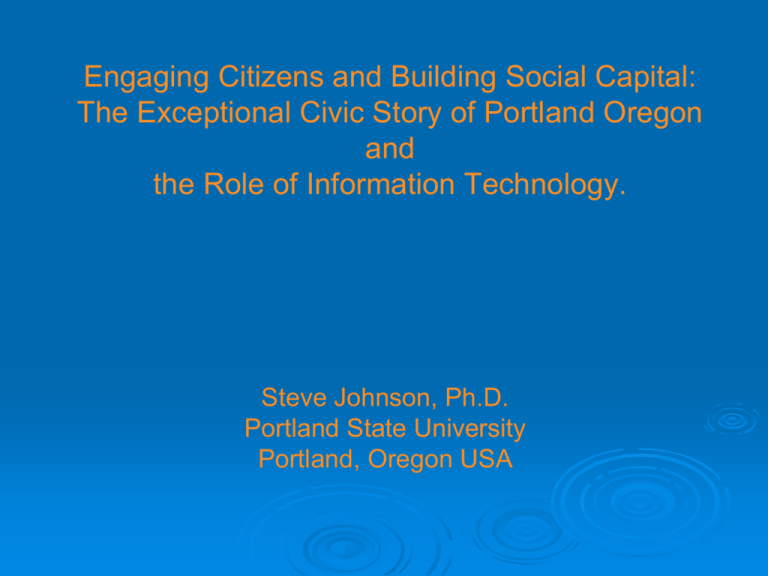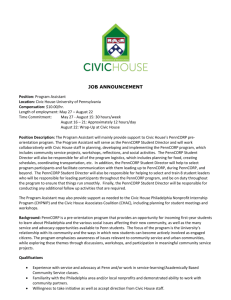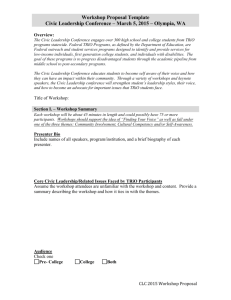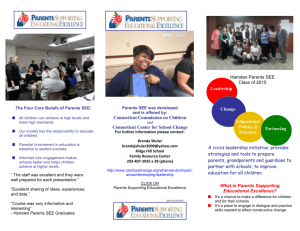Document 9490047
advertisement

Engaging Citizens and Building Social Capital: The Exceptional Civic Story of Portland Oregon and the Role of Information Technology. Steve Johnson, Ph.D. Portland State University Portland, Oregon USA Background Experiments with online communications early 1970s Social network project on Arpanet, 1978 First NGO computer technical assistance network, late 1980s Where is Portland Oregon? Portland Oregon Metropolitan population: 1.5 million State of Oregon: 3.5 million 98,000 square miles Trends of Civic Engagement in America www.BowlingAlone.com What is social capital? If physical capital is wholly tangible, being embodied in observable material form, and human capital is less tangible, being embodied in the skills and knowledge acquired by an individual, social capital is less tangible yet, for it exists in the relations among persons. Example, a park that is safe in a neighborhood vs. having to secure it with police Civic engagement and Trust A society characterized by generalized reciprocity is more efficient than a distrustful society Frequent interaction among a diverse set of people tends to produce a norm of generalized reciprocity. Civic engagement and social capital entail mutual obligation and responsibility for action. AVERAGE MEMBERSHIP RATE IN 32 NATIONAL CHAPTER-BASED VOLUNTARY ASSOCIATIONS 1900-1997 World War II Mean membership rate for the 20th century World War I Great Depre ssion 1900 1910 1920 1930 1940 1950 1960 1970 1980 1990 2000 ATTENDANCE AT PUBLIC MEETINGS ON LOCAL AFFAIRS COLLAPSES 25% 20% 15% 10% 5% 0% 1970 1975 1980 1985 1990 1995 FAMILY DINNERS BECOME LESS COMMON 1977-1999 60% “Our whole family usually eats dinner together.” (married respondents only) 50% Generally o r mo derately agree 40% Defi nite ly Ag ree 30% Disa gree 20% 10% 0% 1975 1980 1985 1990 1995 2000 FOUR DECADES OF DWINDLING TRUST-ADULTS AND TEENAGERS 1960-1999 Percent 60 Who say “most people can be trusted” 50 instead of you can’t 40 be too careful in dealing with people.” 30 Adu lts (mul tisurvey averag e) High school stu dents 20 10 0 196 0 196 5 197 0 197 5 198 0 198 5 199 0 199 5 200 0 Putnam’s Assessment of social capital and civic engagement decline Causes of Social capital and Civic Engagement decline 5% 10% 10% Tim e an d Mone y 25% Electron ic ente rtain ment Genera tion al sub urban izatio n oth er 50% Character of Today’s Civic Participation The more that activities depend on the actions of others, the greater the drop-off in participation. Cooperative forms of behavior have declined more rapidly than expressive forms of behavior (e.g. letter writing) More citizens participate through issue focused groups, extreme views are overly represented The Exceptional Civic Life of Portland, Oregon Photo courtesy of Portland Oregon Visitors Association Depth of Citizen Participation in Portland and Oregon 3000 civic organizations 1 out of 15 people significantly involved in civic life Current neighborhood system, 60 paid staff, 600+ volunteer positions with neighborhood associations Honors Best Bicycling city (Bicycling magazine) Best Walking City (Prevention magazine) Most Sustainable Policies (SustainLane) Most Vegan Friendly (Vegetarian magazine) Most Enlightened (Utne Reader) Best city for dogs (Dog Fancy magazine) Most woman-owned businesses (SBA) Second best city for disabled citizens One of the most attractive for young creatives (Rise of Creative Class) The Health of a Civic Infrastructure Elements of a Healthy Civic Infrastructure Opportunity Effective actions Civic Space Global & Local Facilitative leadership Deliberative Democratic dialogue Sustainable civic story These Audiences Young Elder New comers Disadvantaged Challenging groups Diverse population Wisdom of Crowds Wisdom of Crowds Difficult choice facing American democracy predicted by De Tocqueville Many social and environmental problems can’t be solved without participation (chart) Government becomes facilitator of community problem solving Citizens need new civic skills and knowledge to be effective citizens The example of naming a candy bar Hardware and Software Solutions Problem Hard solution Defensive spending Soft solution Crime Police Security systems Prisons Sewer system Collection/ incineration Pentagon spending Community policing Water pollution Waste War Child care Commuting Property loss/ Health care Storm water disconnect Recycling Diplomacy “welfare” spending Private providers extended family Neighbors More/better highways car pooling Flex car Mass transit Insurance Neighborliness Barn raising Preventative health Social network support care giving Civic Engagement and the Internet Overview of Internet Use Internet and Broadband 1996--2006 Internet Users Demographics of Internet Users February--April 2006 survey Total Adults Gender Women Men Age 18-29 30-49 50-64 65+ Race White Black English Speaking Hispanic Type of Community Urban Suburban Rural Income Less than $30,000/yr $30,000-$49,999 $50,000-$74,999 $75,000Education Less than high school High school Some college 73% 71% 74% 88% 84% 71% 32% X X 73% 61% 76% 75% 75% 63% 53% 80% 86% 91% X 40% 64% 84% X Growth of use of Internet by NGOs 80% 70% 60% 50% 40% 30% 20% 10% 0% yr. 2000 yr. 2002 yr. 2004 Access to Political Information and Public Affairs Americans Getting More News Online News: the double edged sword Internet features such as customization can narrow the information obtained online. Latest surveys show that more people now only access standard news sources, just online now. E Government E Government--Use Profile 97 million or 77% of internet users have gone online to search for government information and to communicate with them. More Americans contact government by telephone but the WWW is the second most popular means Internet users accessing government information online are more successful in achieving their purpose (65% to 53% margin) Digital Divides Most Important Digital Divides--in terms of civic engagement Age. Highest along young, lowest among older Americans Educational Attainment. High among college graduates, low without high school diplomas Income. Highest use with households with $75,000 or more Disability Status—low with people with disabilities Language Preference—low among people with language other than English Race and ethnicity—Highest among Whites and Asian-Americans, lower among African Americans Community type—Highest in urban and suburban areas, lowest in rural areas Digital Divide: Education High School Incomplete A. Look for information you needed for your work? B. Home finances or banking? C. Look for information about a product that you might want to buy? D. Actually buy something? E. Invest money in a stock or mutual fund? F. Tried to meet people for social purpose G. Look for information about a health concern or medical problem? H. Make an airplane or other travel reservation? I. Locate someoneХs phone number, email, or mailing address? J. Play a game with someone on another computer K. Look for a new job or explore career opportunities? L Go to chat room, news group to discuss public affairs M. Go to a Web site to find info about political/policy issues, current affairs, or campaigns? High School Graduate Some College College Graduate Graduate School 42% 45% 56% 74% 84% 34 39 58 59 63 74 50 71 42 80 56 88 70 86 71 6 9 14 22 21 27 16 15 15 11 57 55 61 66 69 24 25 42 55 55 49 50 51 55 66 32 24 22 17 12 37 37 49 50 48 32 20 19 20 22 18 23 75 39 50 X X Civic Engagement Gap Internet does not appear to be increasing youth involved in civic life The youngest and least educated remain the least involved Older and well education the most involved Local Places and Non-Local Places Putnam on Importance of Place “Technologies like the Internet mean that our connections with people around the country and around the world are getting closer, while our ties to our neighbors across the street are weakening.” (Putnam) Loss of Local Citizens access more national but not local news online Some evidence suggests long distance social networks strengthened at expense of local social networks Blogs, likewise tend to be about general news and information not local Public Space and Deliberative Democracy Public or Civic Space Habermas linked the birth of the modern liberal democracy during the 18th century to the emergence of public spaces, such as coffeehouses, clubs, salons, societies, and voluntary associations, and the press where the public can organize itself as the bearer of public opinion. He also noted the current trend to privatize public space which undermines the role of civic space. Deliberative Democracy The internet prompts more knee-jerk reactions than deliberative responses (Stephen Bates, Annenberg) And when there is more interesting discourse, you can tell it's people who just love to hear the sound of their own voices. They're not really listening to other people. It gives people a way to respond instantly and often angrily and aggressively without taking the time to mull something over. The Blog World 30% (50 million) of all American Internet users visited a Blog site in first quarter of 2005 8% (12 million) adult users of the Internet have a blog 54% of bloggers say that they have never published their writing or media creations More than half (54%) of bloggers are under the age of 30. bloggers are less likely to be white than the general internet population. Conclusion Social and Political Characteristics of Online World--organizations Organizational membership may be loose, drive by, quick to form and quick to dissolve Increase in intra-organizational communication Local groups can have more national and global ties and perspective Social networks displacing traditional group membership, “networked individuals” Strengthening affinity groups at expense of cross-differences Social and Political characteristics-Individual May increase expressive forms of citizen participation Individual actions may have more power Fosters weak ties at a distance Citizens may retreat to comfort zones Community moves in doors may be hard to detect Broadband Growth 100% 88% 90% 80% 70% 84% 73% 71% 66% 60% 50% 2006 2005 42% 40% 32% 29% 30% 20% 10% 0% Internet users broadband 18-29 30-49 50-64 over 65 Crowds of Wisdom Software Wikipedia RSS feeds Del.icio.us Facebook Podcasts Youtube Bit Torrent Flickr Digg FlashofBrilliance.net Traffic It’s a “Long Tail” world – Chris Anderson notion 20%-40% of traffic or sales in the “long tail” Content NGOs and the Long Tail The increasing willingness of individuals to make online transactions plus the significantly lower transaction costs of online giving has flipped this longstanding rule on its head. As a result, organizations and campaigns are experiencing an increase in the number of smaller contributions. For example, Dean for America raised more money than any Democratic presidential primary campaign in history, all with donations averaging less than $100 each. Civic Democracy--Innovations Democracy Portal--Seattle Open Politics, Canada Moveon.com Popandpolitics.com and Rock the Vote Meetup.com http://dowire.org/ Democracies online Blog Advokit ChangeEverything Sponsored by large credit union/bank in Canada People list their social and environmental goals Others share theirs, support groups form to help individuals meet their goals Civic Engagement and Internet Scorecard Opportunity Access to Information Civic Innovation Public and civic Space Deliberative democracy mobilization of resources think global act local Local knowledge and stories Audiences Young New Comers Elder Disadvantaged Diverse population Increases Increases Increases Critical Problem Critical Problem increases Increases Critical Problem Mixed uncertain Critical Problem Mixed uncertain EXTRA SLIDES The Digital Natives NPO Computing General support, http://www.501c3cast.com/# PACE, Philanthropy for new style of NPO E-Volve Foundation, support for online civic engagement Craig’s List Bay Area Boot Camp Community Technology Center’s Network http://www.ctcnet.org/ What to Do in the Civil Society Sector Design connective strategies Push power to the edges Meet them where they are Learn from and with the grassroots Membership alone is not enough Need for organizational flexibility (like Dell Computer) Develop New sets of civic skills Take advantage of spontaneous intelligent mobs Civic Engagement: Definition Civic engagement refers to activities by which people participate in civic, community and political life and by doing so express their commitment to community Such activities include volunteering, voting, community organizing, political advocacy What Information Citizens Access Got information from government WWW site Conducted research Tourist information Health and safety information Sent email to government employees Government benefits 66% 41% 34% 28% 27% 23%








